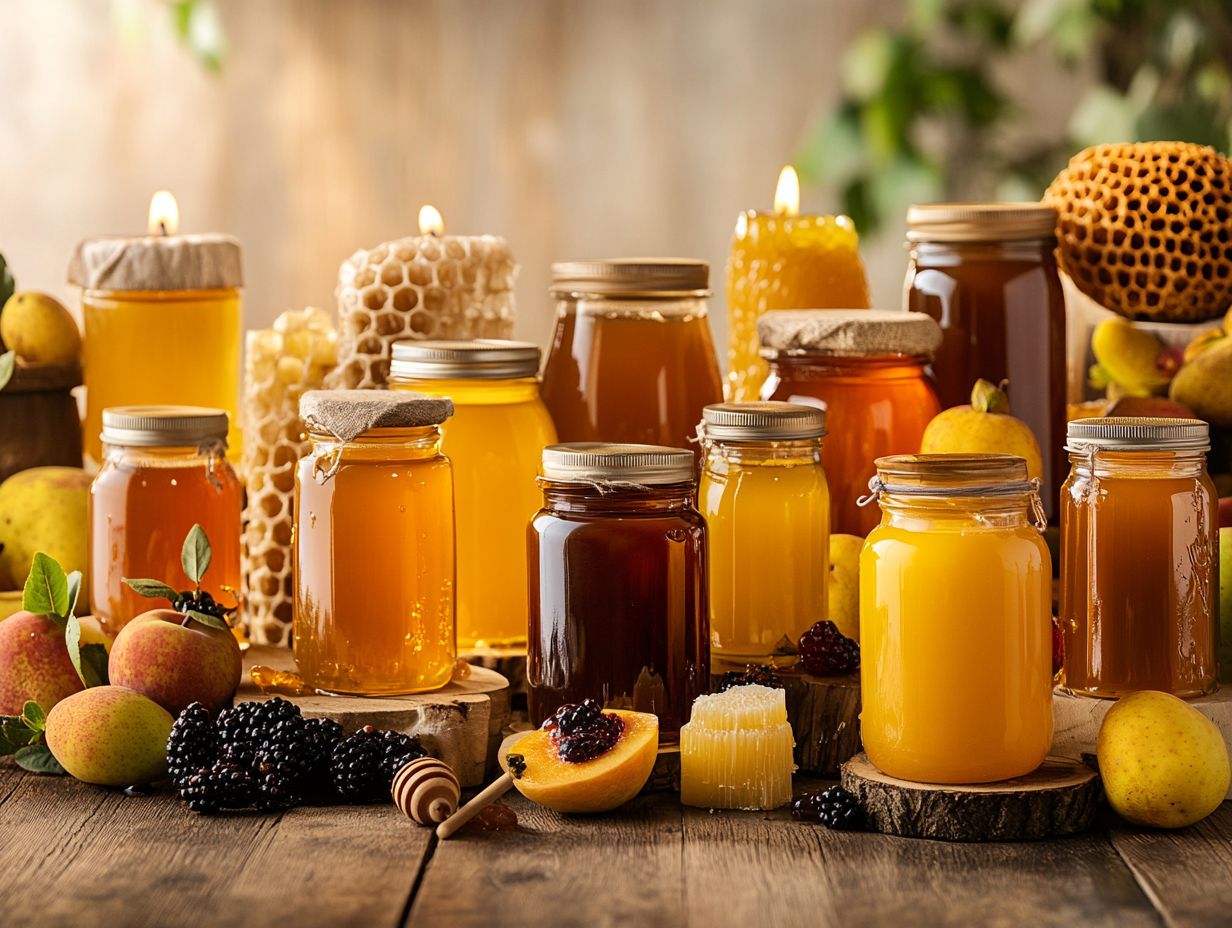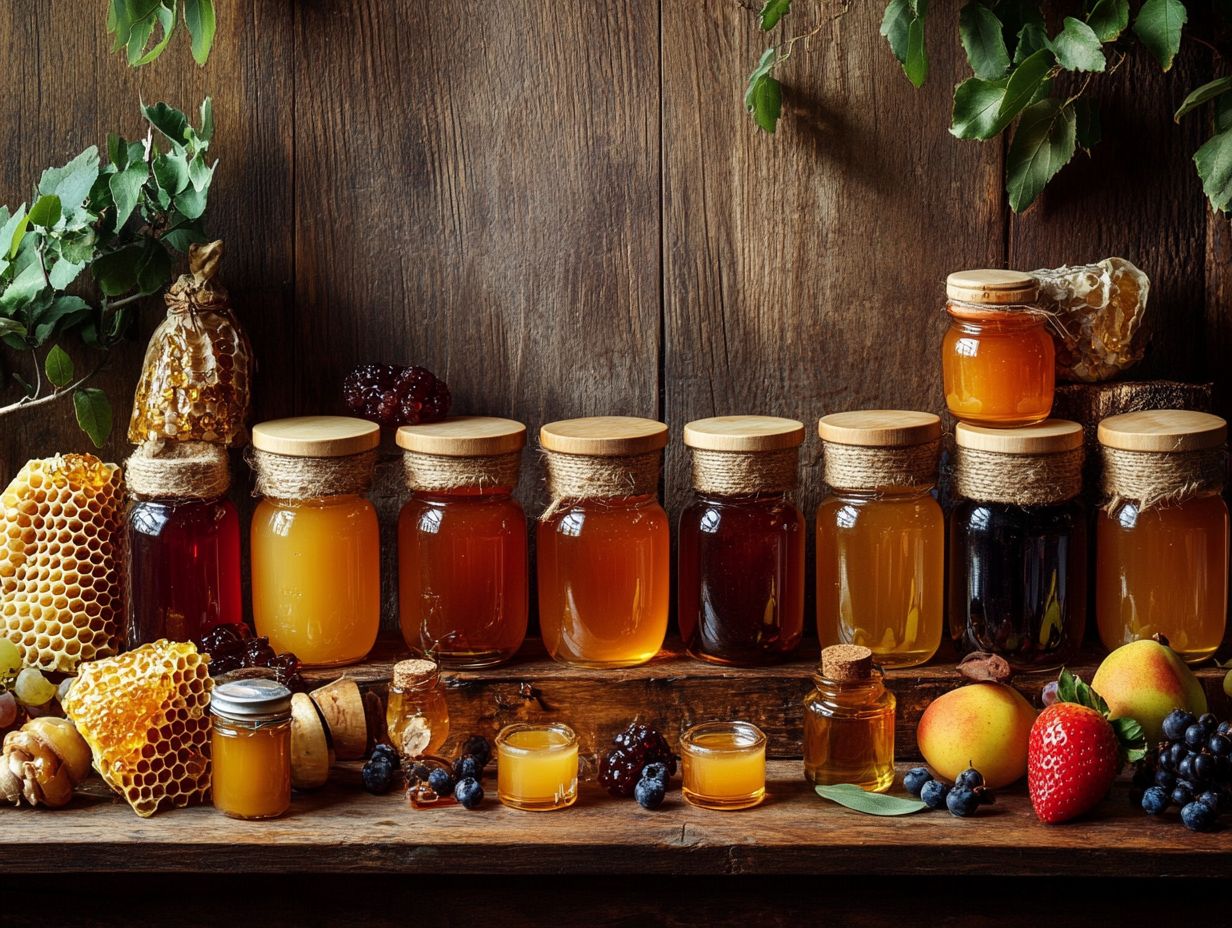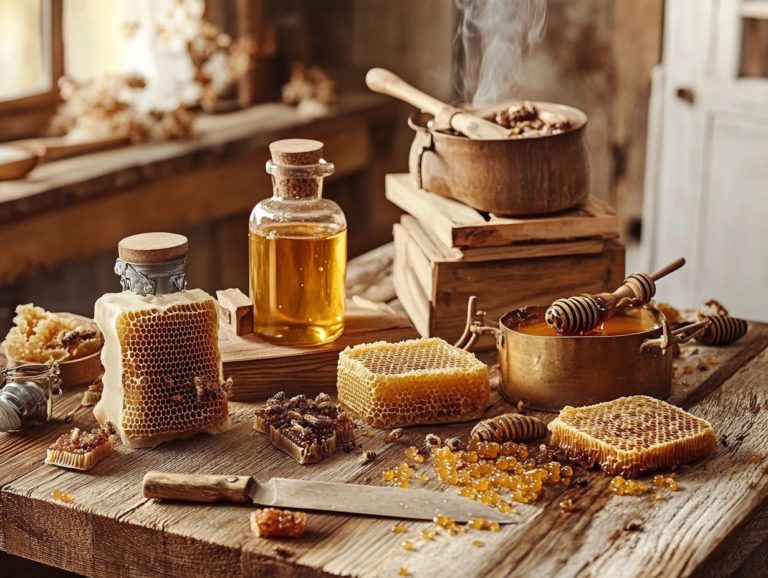Exploring the Different Types of Honey
Honey transcends being merely a sweetener; it’s a captivating natural product teeming with diversity. It showcases a variety of honey types, each presenting its own unique flavors and health benefits.
From the tangy richness of Manuka honey to the delicate notes of Acacia honey, and even the fragrant allure of Orange Blossom honey, an entire world of taste awaits your exploration.
This article delves into the myriad types of honey, highlighting their remarkable health advantages and offering guidance on selecting the perfect one to suit your needs.
Whether you consider yourself a honey aficionado or are simply curious about the health benefits of honey, you’re bound to discover something fascinating!
Contents
- Key Takeaways:
- What are the Different Types of Honey?
- What are the Health Benefits of Honey?
- How to Choose the Right Type of Honey?
- Frequently Asked Questions
- What are the different types of honey?
- What is the difference between raw and pasteurized honey?
- Can you explain the difference between monofloral and polyfloral honey?
- What is the best way to use honey in cooking and baking?
- Is there a difference between organic and non-organic honey?
- What are the potential health benefits of different types of honey?
Key Takeaways:
- Honey comes in a variety of types, each with its own unique flavor and characteristics.
- Aside from being a delicious natural sweetener, honey also provides numerous health benefits, such as fighting off bacteria and boosting the immune system, thanks in part to its antioxidants.
- When choosing honey, consider factors such as flavor, color, quality certifications, source, and processing methods to find the best fit for your needs.
What are the Different Types of Honey?
Honey serves as a remarkable and versatile natural sweetener, presenting itself in various forms, each shaped by the unique nectar source from which it originates.
In this exploration, you will delve into the various types of honey, including raw honey, clover honey, wildflower honey, buckwheat honey, and the esteemed manuka honey from New Zealand.
With such a plethora of honey varieties at your fingertips, each type offers distinctive flavor profiles, colors, and health benefits. This makes honey not merely a delightful addition to your culinary creations but also a potent ally in natural remedies and gourmet practices, including lavender honey for unique flavor.
1. Raw Honey
Raw honey is a true treasure, unprocessed and unpasteurized. This allows it to retain its natural enzymes, antioxidants, and beneficial compounds that offer a myriad of health benefits.
Unlike processed honey, which often sacrifices these essential nutrients due to high heat and filtration, raw honey boasts a rich, complex flavor profile that dances between floral and fruity notes. Its versatility shines through when you drizzle it over yogurt or incorporate it into marinades. With its remarkable antibacterial properties and antioxidants, raw honey is a go-to for soothing sore throats and enhancing overall well-being.
By weaving raw honey into your diet, you elevate your sweetening game and give your immune system a boost. It’s more than just a sweetener; it’s a holistic remedy that can enhance your life in many ways.
2. Manuka Honey
Manuka honey, sourced from the nectar of the manuka tree in New Zealand, is highly esteemed for its unique health benefits and powerful medicinal properties. This remarkable honey has a distinct flavor profile and is filled with antioxidants, contributing to its celebrated reputation in the world of natural remedies.
Scientific research has increasingly illuminated its impressive antibacterial qualities, particularly due to a natural compound that enhances its antibacterial properties. This exceptional honey is making waves in natural health markets around the globe, and you may find it in skincare products, where its healing properties work to combat inflammation and promote skin rejuvenation.
Dive into the world of honey today and discover which flavor will become your new favorite!
3. Clover Honey
Clover honey, harvested from the nectar of clover flowers, is one of the most beloved honey varieties. It’s celebrated for its mild flavor and light, inviting hue.
This delightful sweetness is perfect for drizzling over pancakes or stirring into your tea. It enhances your dishes without overwhelming your taste buds. Its smooth, creamy texture also works wonders in baking, serving as an excellent sweetener for breads, cookies, and cakes.
Rich in antioxidants and essential minerals like calcium and potassium, clover honey contributes to your overall health. Its natural antibacterial properties make it a valuable ally in soothing sore throats and tackling digestive issues.
It’s a versatile ingredient that delights the senses and supports your well-being. Try incorporating clover honey into your morning routine for a sweet start!
4. Buckwheat Honey
Buckwheat honey is a dark, robust delight known for its strong flavor and impressive antioxidant content.
Its distinct flavor is often described as malty, with hints of molasses that elevate your culinary creations. The dark amber hue speaks to its richness and essential nutrients.
Rich in antioxidants, buckwheat honey may bolster your immune system and support heart health. In the kitchen, reach for it in marinades, dressings, and baked goods, where it adds depth and complexity to your dishes while providing a nutritious alternative to refined sugars.
5. Acacia Honey
Acacia honey, derived from the nectar of the Acacia tree, captivates with its light hue and delicate flavor.
This unique sweetness delights your palate and offers remarkable versatility. It’s ideal for drizzling over pancakes, stirring into tea, or using as a natural sweetener in various recipes.
Its mild flavor profile enhances rather than overshadows other ingredients, making it a favorite among chefs and home cooks. With a lower measure of how quickly food affects your blood sugar than many conventional sweeteners, Acacia honey is a healthier option for those mindful of their blood sugar levels.
Its slow crystallization maintains its liquid form longer, preserving exquisite flavor and health benefits, including antioxidant properties that contribute to your overall well-being.
6. Alfalfa Honey
Alfalfa honey, with its light color and mild, pleasant flavor, serves as a versatile sweetener for a range of culinary delights.
This honey is often marked by subtle floral notes and a whisper of mild earthiness. It enhances everything from your favorite beverages to delectable baked goods.
Use it in your kitchen; it pairs beautifully with teas, yogurt, and marinades, providing a gentle sweetness that won’t overshadow other ingredients. Beyond taste, alfalfa honey is celebrated for its nutritional benefits and role in promoting digestive health.
Packed with antioxidants and essential vitamins, it boosts the immune system. Incorporating alfalfa honey into your diet is a delicious way to enrich your overall well-being.
7. Eucalyptus Honey
Eucalyptus honey is a treasure, especially for those seeking health benefits for respiratory conditions and its medicinal properties.
This exceptional honey comes from the blossoms of eucalyptus trees in Australia. Its rich, herbal notes and subtle menthol essence create a delightful experience, perfect for elevating your teas and enhancing baked goods.
Eucalyptus honey has impressive antiseptic properties that help fight infections and aid in wound healing.
These qualities show its value as a natural remedy, making it a sought-after ingredient for health-conscious individuals who appreciate nature’s gifts.
8. Sage Honey
Sage honey has a unique flavor profile from sage plants, making it a coveted ingredient for its cooking uses and health benefits.
You’ll find its taste to be distinctly aromatic and subtly herbaceous, adding an intriguing twist to sweet and savory dishes. Chefs often use sage honey in marinades, salad dressings, and glazes, enhancing flavors with its complex floral notes.
In desserts, it pairs exquisitely with fruits, whether drizzled over cheesecake or mixed into yogurt.
Beyond cooking, sage honey supports digestive health by alleviating stomach issues and promoting a healthy gut.
With its antioxidant properties, it has become a favorite for those who prioritize natural remedies.
9. Orange Blossom Honey
Orange blossom honey presents a fragrant and citrusy flavor, making it perfect for teas and desserts sourced from orange tree blossoms.
This distinctive honey has a light golden hue and smooth texture, elevating various culinary creations.
The mild sweetness and subtle hint of orange make it an excellent choice for drizzling over Greek yogurt or mixing into salad dressings.
As a versatile sweetener, it harmonizes beautifully with cheese, particularly creamy varieties.
Its vibrant aroma can enhance baked goods, infusing them with a bright note that complements both sweet and savory dishes.
Explore the multifaceted uses of this honey, and you’ll discover its rich flavor profile.
10. Tupelo Honey
Tupelo honey, derived from the blossoms of the tupelo tree, is renowned for its exceptional buttery flavor and striking golden hue.
Experience the delightful sweetness of this remarkable honey, which enhances both savory and sweet dishes.
Chefs often use tupelo honey in salad dressings, marinades, and glazes, showcasing its ability to harmonize with other flavors.
Tupelo honey also has potent health benefits. With its anti-inflammatory properties and rich antioxidants, it significantly contributes to overall wellness.
Its lower glycemic index makes it a preferred natural sweetener for those mindful of blood sugar levels.
With its unique flavor and health benefits, tupelo honey distinguishes itself among bee products.
What are the Health Benefits of Honey?
Honey is more than just a natural sweetener; it’s a treasure trove of health benefits due to its rich antioxidants and medicinal properties.
Numerous studies highlight honey’s ability to aid in wound healing, bolster your immune system, and soothe ailments like coughs and sore throats.
With a range of varieties, from manuka to buckwheat honey, each type offers unique health contributions, making honey an invaluable addition to your diet.
Start enjoying these health benefits today by adding honey to your meals!
1. Antibacterial and Antimicrobial Properties
One of the most remarkable health benefits of honey lies in its potent antibacterial and antimicrobial properties, celebrated for centuries.
Among the diverse varieties, manuka and buckwheat honey truly shine due to their exceptional natural compositions.
Manuka honey, derived from the nectar of the manuka tree in New Zealand, boasts high levels of methylglyoxal. This impressive compound is known for its effectiveness against bacterial infections.
Research demonstrates that its potency goes beyond conventional applications, making it a favored choice for wound treatment and infection prevention.
On the other hand, buckwheat honey, with its rich, dark hue and elevated antioxidant levels, also displays strong antibacterial properties. Both of these honeys have gained traction not only within holistic health communities but also in modern medicine, further cementing their importance in the realm of natural healing.
2. Soothes Sore Throats and Coughs
Honey stands as a revered remedy for soothing sore throats and alleviating coughs, delivering both comfort and notable health benefits.
This timeless treatment has been cherished across cultures for centuries. It has often been lovingly handed down from one generation to the next.
Increasingly, scientific research backs its effectiveness, revealing that honey possesses natural antibacterial and anti-inflammatory properties.
Certain varieties, like Manuka honey, are particularly esteemed for their superior healing abilities, thanks to their unique compounds.
Studies indicate that honey can effectively coat the throat, alleviating irritation and reducing nighttime coughing, making it a favored option for those in search of relief.
When you combine honey with warm water or lemon, you enhance the soothing experience, creating a comprehensive approach to tackling these common ailments.
3. Boosts Immune System
Enjoying honey regularly can supercharge your immune system, thanks to its abundant antioxidant content and natural properties.
This delightful substance, especially in its raw form, is brimming with nutrients that work together to bolster your body’s defense mechanisms.
Varieties like Manuka honey have garnered attention for their exceptional ability to combat harmful bacteria and support gut health.
The antioxidants found in honey, including flavonoids and phenolic acids, play a pivotal role in neutralizing free radicals, thus reducing oxidative stress in your body.
This not only strengthens your immune response but also promotes overall well-being, making honey a delicious and beneficial addition to your balanced diet.
4. Promotes Wound Healing
Honey has been a cherished remedy for centuries, renowned for its ability to promote wound healing through its natural antiseptic and healing properties.
This age-old solution isn’t merely a relic of folklore; recent research has unveiled its impressive array of benefits.
For example, honey creates a moist healing environment that not only reduces pain but also encourages tissue regeneration.
Studies highlight manuka honey as particularly exceptional, boasting unique antibacterial properties due to its high methylglyoxal content, which truly distinguishes it from regular honey.
Clinical trials have demonstrated its effectiveness in speeding up healing across various kinds of wounds, including surgical incisions and diabetic ulcers.
The use of honey in treating burns has yielded promising results, showcasing its potential as a powerful, natural therapeutic agent in contemporary medicine.
How to Choose the Right Type of Honey?
Selecting the ideal type of honey requires thoughtful consideration of several factors, including flavor profiles, health benefits, and the honey’s source—along with any applicable quality certifications.
With a myriad of honey varieties at your fingertips, it’s crucial to reflect on your taste preferences, the specific health benefits you’re seeking, and whether you lean toward raw honey or pasteurized options.
Explore the wonderful world of honey today and find your perfect match!
1. Consider the Flavor and Aroma
When selecting honey, prioritize the flavor and aroma, as each variety offers a distinct tasting experience.
Take clover honey, for instance. Its light, sweet taste with subtle floral notes can elevate everything from gourmet dishes to dessert recipes. This makes it a beloved choice among chefs.
On the other hand, wildflower honey, sourced from a diverse array of blossoms, boasts a more robust flavor profile that can range from spicy to fruity. This versatility makes it perfect for enhancing marinades and dressings.
These varied sensory attributes not only enrich your culinary creations but also encourage experimentation in baking. The choice of honey can significantly impact the sweetness and texture of pastries. By understanding these distinctions, you empower yourself to select the ideal type for your recipes, unlocking the full potential of honey in your kitchen.
2. Check the Color and Consistency
The color and consistency of honey offer valuable insights into its quality, with raw honey typically appearing cloudier than its processed counterpart. This cloudiness often stems from the presence of pollen and natural particles that are commonly filtered out during the heating process.
Honey can exhibit a wide range of hues, from light amber to deep brown. These variations reflect the specific floral sources of the nectar. For example, honey from clover blossoms tends to be lighter, while buckwheat honey usually has a darker appearance and a more robust flavor.
Each type brings its own unique taste and aroma, which play a significant role in shaping your assessment of quality and personal preference. Recognizing these color variations aids in understanding the floral origins and highlights the differences in processing methods that can impact both taste and nutritional value.
3. Look for Quality Certifications
Look for quality certifications to ensure you pick the best honey that aligns with your health goals.
Certifications like organic or raw indicate that the honey has been produced without harmful pesticides or additives, preserving its natural health benefits. Organic honey comes from beekeepers who adhere to strict guidelines, ensuring that the bees aren’t exposed to chemical fertilizers or synthetic treatments. This commitment results in a pure product, brimming with antioxidants—compounds that help protect your cells from damage—enzymes, and vitamins that can enhance your overall wellness.
By prioritizing these standards, you can make informed choices that not only support your personal health but also promote sustainable practices within the beekeeping industry, helping to protect bees vital to our ecosystem.
4. Consider the Source and Processing Methods
Understanding the source and processing methods of honey, such as Tupelo honey and dark honey, is crucial, as they can significantly influence its flavor and health benefits.
When you choose local honey, you directly support producers who emphasize sustainable practices and eco-friendly sourcing. This results in a product that’s not only fresher but also richer in flavor. On the other hand, commercial honey typically undergoes extensive processing, including a heating process that extends shelf life but can strip away beneficial enzymes and alter its natural taste.
This distinction is essential: raw honey retains its natural pollens and antioxidants, offering a wealth of health advantages. In contrast, processed honey might have a more uniform texture but falls short in terms of those benefits. The choice between these options impacts your health and supports local economies while fostering responsible beekeeping practices.
Conclusion: Selecting quality honey not only enhances your culinary experiences but also supports your health and the environment. Make informed choices to enjoy the myriad benefits of this natural sweetener!
5. Read Reviews and Recommendations
Dive into the wonderful world of honey! Reading reviews and recommendations from sources like Healthline can offer you great advice into the best types and brands of honey to suit your tastes.
By evaluating the flavor profiles and health benefits of various honey options, you’ll be empowered to make informed choices tailored specifically to your taste and wellness aspirations.
As you explore the world of honey, consider focusing on organic or raw varieties. These often showcase higher antioxidant levels—substances that may help protect your cells—and potential medicinal properties, as many reviews emphasize.
The personal experiences in testimonials can reveal unique qualities of lesser-known brands, possibly introducing you to artisanal options that match your palate and dietary requirements beautifully.
Additionally, some of these unique varieties may remind you of those found in ancient Egyptian tombs.
Frequently Asked Questions
What are the different types of honey?
There are many different types of honey available, each with its own unique flavor and characteristics. Some common types include clover, wildflower, manuka, and buckwheat honey.
What is the difference between raw and pasteurized honey?
Raw honey is unheated and unfiltered, retaining all of its natural enzymes and nutrients. Pasteurized honey has been heated and processed, which can affect its flavor and nutritional value.
Can you explain the difference between monofloral and polyfloral honey?
Monofloral honey is made primarily from the nectar of one type of flower, while polyfloral honey contains nectar from a variety of different flowers. The type of flower(s) the bees gather nectar from can greatly influence the taste and color of the honey.
What is the best way to use honey in cooking and baking?
Honey can be used in a variety of ways in the kitchen, from sweetening tea and coffee to adding flavor to marinades and dressings. It can also be used as a replacement for sugar in many baking recipes.
Is there a difference between organic and non-organic honey?
Organic honey is produced from bees that have been raised on organic land and have not been exposed to synthetic pesticides or chemicals. Non-organic honey may contain traces of these chemicals, depending on the beekeeping practices used.
What are the potential health benefits of different types of honey?
Each type of honey may have its own unique health benefits, as they contain varying levels of antioxidants, vitamins, and minerals. Some studies have shown that honey may have antibacterial and anti-inflammatory properties, and may also help soothe sore throats and boost the immune system.
Start exploring different honey options today and find your favorite!





